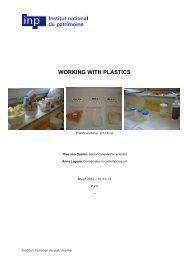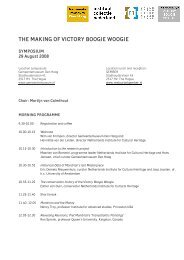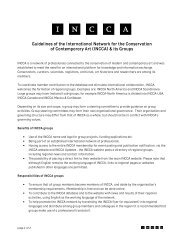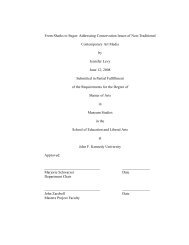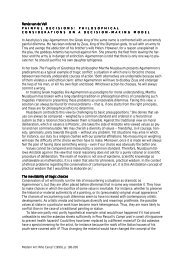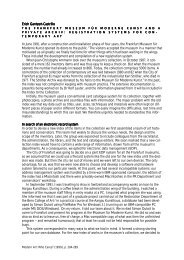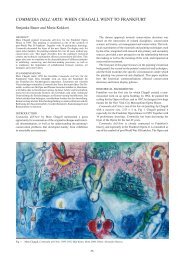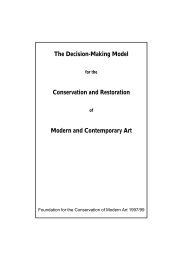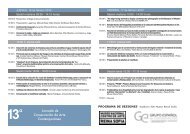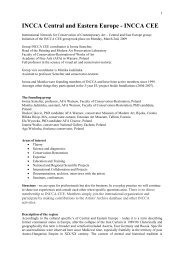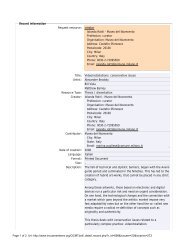Conservation Issues of Modern and Contemporary Art ... - The Getty
Conservation Issues of Modern and Contemporary Art ... - The Getty
Conservation Issues of Modern and Contemporary Art ... - The Getty
Create successful ePaper yourself
Turn your PDF publications into a flip-book with our unique Google optimized e-Paper software.
set <strong>of</strong> issues, in particular the need to consider several new aspects in works <strong>of</strong><br />
contemporary art that should be documented beyond the physical object—such as the<br />
significance, value, <strong>and</strong> meaning <strong>of</strong> materials, sound, motion, <strong>and</strong> even smell—<strong>and</strong> to<br />
develop strategies <strong>and</strong> methodologies for documenting them. It is also imperative that<br />
a more st<strong>and</strong>ardized terminology is developed within the pr<strong>of</strong>ession to ensure that this<br />
documentation is easily shared <strong>and</strong> understood.<br />
Specific issues that were identified include a need to:<br />
• <strong>of</strong>fer more descriptions <strong>of</strong> why a decision to treat an object (or not) was made;<br />
• <strong>of</strong>fer more instructions/information from the artist <strong>and</strong>/or manufacturers;<br />
• document works <strong>of</strong> art as soon as possible after they are made;<br />
• gain access to other conservators’ unpublished records/archives;<br />
• address the fact that because a diversity <strong>of</strong> approaches/models are currently<br />
used by different collections for installation art, information sharing is very<br />
difficult;<br />
• manage obsolete technology <strong>and</strong> the data from time-based media works;<br />
• devise a process to document Web art (which can suddenly disappear <strong>of</strong>fline);<br />
• develop a method to characterize the patinas on bronze sculptures.<br />
Dissemination <strong>and</strong> Information Sharing<br />
Communication <strong>and</strong> information exchange within <strong>and</strong> beyond the pr<strong>of</strong>ession is<br />
inadequate. Despite the existence <strong>of</strong> pr<strong>of</strong>essional networks—for example, INCCA (<strong>The</strong><br />
International Network for the <strong>Conservation</strong> <strong>of</strong> <strong>Contemporary</strong> <strong>Art</strong>), ICOM-CC: MMCA<br />
(the <strong>Modern</strong> Materials <strong>and</strong> <strong>Contemporary</strong> <strong>Art</strong> working group <strong>of</strong> the International<br />
Council <strong>of</strong> Museums–<strong>Conservation</strong> Committee), <strong>and</strong> AMIEN (<strong>Art</strong> Materials Information<br />
<strong>and</strong> Education Network)—these are still under-utilized; they remain, however, the<br />
logical vehicles for creating far more dynamic forms <strong>of</strong> networking <strong>and</strong> dissemination.<br />
<strong>The</strong>re is a clear need for:<br />
• improved communication among colleagues/institutions to share information<br />
more effectively on all aspects <strong>of</strong> conservation (especially research results <strong>and</strong><br />
treatment decisions);<br />
• engaging a broader cross-section <strong>of</strong> the arts pr<strong>of</strong>ession (especially art historians,<br />
artists, collectors, <strong>and</strong> curators) in many <strong>of</strong> the discussions;<br />
• identifying more experts from other fields (e.g., structural engineers <strong>and</strong> video<br />
technicians) who could share useful advice <strong>and</strong> experience on specific issues<br />
<strong>and</strong> types <strong>of</strong> artwork;<br />
• raising awareness within the public through many <strong>of</strong> the discussions <strong>and</strong><br />
debates.<br />
Education <strong>and</strong> Training<br />
It was recognized that the training <strong>and</strong> education <strong>of</strong> more conservators in modern <strong>and</strong><br />
contemporary art is key to progress in the field, <strong>and</strong> that the majority <strong>of</strong> conservation<br />
training programs are already attempting to respond to this need. <strong>The</strong>re remains,<br />
however, a significant amount <strong>of</strong> disagreement on how best to achieve the most<br />
appropriate training for such conservators, <strong>and</strong> on how to get around the limitations <strong>of</strong><br />
existing educational models. Other levels <strong>of</strong> education <strong>and</strong> training possibilities are<br />
also lacking—for example, pre-program <strong>and</strong> mid-career opportunities.<br />
4



